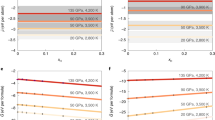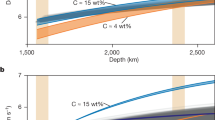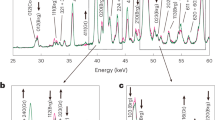Abstract
A pressure of 24 GPa and temperatures of about 2,000–3,000 K correspond to the observed 670-km seismic discontinuity which separates the upper and lower mantle. In such conditions the major minerals of the Earth's upper mantle, olivine ((Mg, Fe)2SiO4), pyroxene ((Mg, Fe)SiO3) and garnet ((Mg, Fe, Ca)3Al2Si3O12) transform to a distorted (orthorhombic) perovskite-structured mineral ((Mg, Fe)SiO3), or to a perovskite-dominated assemblage (refs 1–4). Because silicate perovskite is stable to at least 70 GPa, it is thought to be the most abundant mineral in the lower mantle and, possibly, in the entire Earth. Despite its importance, silicate perovskite was only discovered in 1976, and little is known about its physical properties because of the difficulty in achieving the conditions of pressure and temperature required for the synthesis of this phase. For example, the value of the thermal expansion coefficient of perovskite provides an important constraint on possible compositional models for the lower mantle5–7. We have recently produced sufficient amounts of (Mg0.9, Fe0.1)SiO3 perovskite to measure its zero-pressure thermal expansion to 840 K by X-ray diffraction. At high temperatures, the average thermal expansion coefficient is 4×l0−5K−1. Such a large value for the thermal expansion coefficient implies that standard models of upper mantle composition, such as pyrolite or garnet peridotite (Mg value ≍ 0.89), yield zero-pressure densities that are about 2% lower than that of the density of the lower mantle extrapolated to zero pressure conditions. This result suggests that the upper and lower mantle are chemically distinct, in accord with layered models of the thermal and convective state of the mantle.
This is a preview of subscription content, access via your institution
Access options
Subscribe to this journal
Receive 51 print issues and online access
$199.00 per year
only $3.90 per issue
Buy this article
- Purchase on Springer Link
- Instant access to full article PDF
Prices may be subject to local taxes which are calculated during checkout
Similar content being viewed by others
References
Akaogi, M. & Akimoto, S. Phys. Earth planet. Inter. 15, 90–106 (1977).
Akimoto, S., Yagi, T. & Inoue, K. in High-Pressure Research (eds Manghnani, M. H. & Akimoto, S.) 585–692 (Academic, New York, 1977).
Liu, L. in The Earth: Its Origin Structure and Evolution (ed. McElhinny, M. W.) 177–202 (Academic, New York, 1979).
Yagi, T., Bell, P. M. & Mao, H.-K., Carnegie Instn Wash. 78, 614–615 (1979).
Liu, L. Earth planet. Sci. Lett. 42, 202–208 (1979).
Jackson, I. Earth planet. Sci. Lett. 62, 91–103 (1983).
Jeanloz, R. & Thompson, A. B. Rev. Geophys. Space Phys. 21, 51–74 (1983).
Mao, H.-K., Bell, P. M., Dunn, K.J., Chrenko, R. M. & Devries, R. C. Rev. Scient. Instrum. 50, 1002–1009 (1979).
Barnett, J. D., Block, S. & Piermarini, G. J. Refv. Scient. Instrum. 44, 1–9 (1973).
Mao, H.-K., Bell, P. M., Shaner, J. W. & Steinberg, D. J. J. appl. Phys. 49,3276–3283 (1978).
Liu, L. Phys. Earth, planet. Inter. 11, 289–298 (1976).
Ito, E. & Matsui, Y. Earth planet. Sci. Lett. 38, 435–443 (1978).
Yagi, T., Mao, H.-K. & Bell, P. M. Phys. Chem. Miner. 3, 97–103 (1978).
Yagi, T., Mao, H.-K. & Bell, P. M. Physical Geochemistry (ed. Saxena, S. K.) 317–325 (Springer, New York, 1982).
Suzuki, I. J. Phys. Earth 23, 145–159 (1975).
Suzuki, I., Okajima, S. & Seya, K. J. Phys. Earth 27, 63–69 (1979).
Masters, G., Geophys J.R. astr. Soc. 57, 507–534 (1979).
Dziewonski, A. M. & Andersen, D. L. Phys. Earth planet. Inter. 25, 297–357 (1981).
Birch, F. J. geophys. Res. 69, 4377–4388 (1964).
Jeanloz, R. in Convection in the Earth's Mantle (ed. Peltier, W. R.) (Gordon and Breach, New York, in the press).
Davies, G. F. & Dziewonski, A. M. Phys. Earth planet. Inter. 10, 336–343 (1975).
Dziewonski, A. M., Hales, A. L. & Lapwood, E. R. Phys. Earth planet. Inter. 10,12–48 (1975).
Akimoto, S., Akaogi, M., Kawada, K. & Nishizawa, O. in The Geophysics of the Pacific Ocean Basin and Its Margin (eds Sutton, G. H., Manghnani, M. H. & Moberly, R.) 399–405 (AGU, Washington DC, 1976).
Anderson, D. L. Science 157, 1165–1173 (1967).
Jeanloz, R. & Richter, F. M. J. geophys. Res. 84, 5497–5504 (1979).
Touloukian, Y. S., Kirby, R. K., Taylor, R. E. & Lee, T.Y.R. in Thermal Expansion, Non-metallic Solids (TPRC 13) 1658 (IFl/Plenum, New York, 1977).
Ringwood, A. E. Composition and Petrology of the Earth's Mantle (McGraw-Hill, New York, 1975).
Yoder, H. S. Jr., Generation of Basaltic Magmas (National Academy of Sciences, Washington DC, 1976).
Bell, P. M., Yagi, T. & Mao, H.-K. Yb. Carnegie Instn Wash. 78, 618–619 (1979).
Ito, E. & Yamada, H. in High Pressure Research in Geophysics (eds Akimoto, S. & Manghnani, M. H.) 405–419 (Center for Academic Publishing, Tokyo, 1982).
Lees, A. C., Bukowinski, M. S. T. & Jeanloz, R. J. geophys. Res. 88, 8145–8159 (1983).
Anderson, D. L. A. Rev. Earth planet. Sci. 5, 179–202 (1977).
O'Nions, R. K., Eversen, N. M. & Hamilton, P. J. J. geophys. Res. 84, 6091–6101 (1979).
Jacobsen, S. B. & Wasserburg, G. J. J. geophys. Res. 84, 7411–7427 (1979).
McKenzie, D. & Richter, F. M. J. geophys. Res. 86, 11667–11680 (1981).
Richter, F. M. & Johnson, C. E. J. geophys. Res. 79, 1635–1639 (1974).
Oison, P. J. geophys. Res. 89, 11293–11301 (1984).
Hoffman, N. R. A. & McKenzie, D. P., Geophys. J.R. astr. Soc. 82, 163–206 (1985).
Creager, K. C. & Jordan, T. H. J. geophys. Rƒ(c)s. 89, 3031–3050 (1984).
Author information
Authors and Affiliations
Rights and permissions
About this article
Cite this article
Knittle, E., Jeanloz, R. & Smith, G. Thermal expansion of silicate perovskite and stratification of the Earth's mantle. Nature 319, 214–216 (1986). https://doi.org/10.1038/319214a0
Received:
Accepted:
Issue Date:
DOI: https://doi.org/10.1038/319214a0
This article is cited by
-
High-Pressure Mössbauer Measurements on Nanocrystalline Perovskite (La,Sr)(Mn,Fe)O3
Hyperfine Interactions (2006)
-
Transformation of stishovite to a denser phase at lower-mantle pressures
Nature (1995)
-
New phase for mantle research
Nature (1995)
-
The large-scale structure of convection in the Earth's mantle
Nature (1990)
Comments
By submitting a comment you agree to abide by our Terms and Community Guidelines. If you find something abusive or that does not comply with our terms or guidelines please flag it as inappropriate.



